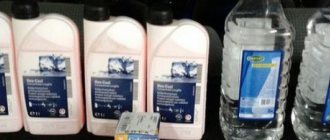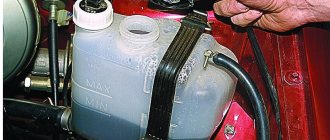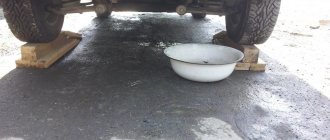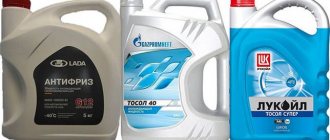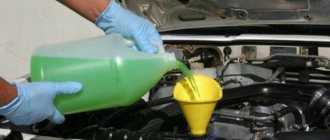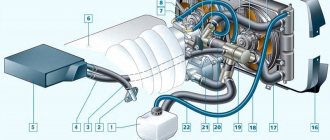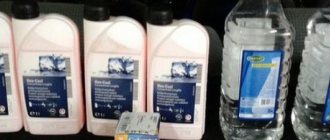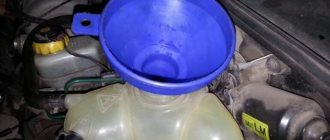When and why is replacement needed?
The main task of antifreeze is to cool the engine while it is running. Most coolants contain water, ethylene glycol, various additives, additives and dyes. They impart anti-corrosion and protective properties. Over time, additives and additives lose their properties, sediment forms, and color changes.
Filling with antifreeze
Let's look at the main cases when replacing antifreeze is required:
- At the end of its service life . Each class of antifreeze has its own service life. For example, silicate-based G11 lasts a maximum of two years, after which it must be replaced. This is especially important for this class, since the active substances form an anti-corrosion film on the surface, which crumbles over time, turning into an abrasive. G13 class antifreezes last from 3 to 5 years if replaced correctly.
- Carrying out repair work . If it is necessary to drain the coolant during repairs, then after completion it is better to fill in new ones.
- Loss of performance properties . Fresh antifreeze has a bright color (blue, red, etc.). If the color of the coolant changes to brown or foam appears, you need to urgently change the fluid. This can happen either as a result of expiration of service life or after mixing different types.
- Boiling and evaporation of liquid . As a temporary measure, you can add another antifreeze or water, but replace the coolant as soon as possible.
We recommend entrusting any car maintenance procedures to professionals, including replacing antifreeze. However, if this is not possible, you can do it yourself, following the necessary algorithm of actions and precautions.
How to choose the right antifreeze
The abundance of brands and specifications of antifreeze often confuses the buyer. Most car owners distinguish antifreezes according to the following characteristics:
- name - antifreeze or antifreeze;
- color - green, red, blue and yellow coolants are available on sale;
- identification marker (G11 and G12).
In modern conditions, antifreeze is completely synonymous with antifreeze. Antifreeze was developed in the USSR in the 70s, therefore it has a domestic name. Antifreeze is the Western name for this auto chemical product; over time, it has taken root in Russia. Both are coolants and have identical functions and properties.
Although the color of antifreeze matters, it is not exactly what car owners understand. There is even a misconception that green antifreeze is of poor quality, but red is the best.
The term “coolant” is in fact the most correct and accurate designation for such compositions
Of course, the recommendations not to mix antifreeze of different colors should be followed, but you cannot rely only on color. The color is given to antifreeze using dyes at the factory; it is intended primarily for the manufacturers themselves, so as not to confuse product batches.
The manufacturer may well paint the coolant a certain color, although its chemical composition may not be compatible with antifreeze of a similar color from another factory.
Another marker gradation (G11 and G12) is also not entirely logical. It is intended exclusively for cars of the VAG concern (Volkswagen, Skoda, Audi, etc.), which developed it. Therefore, it is not entirely correct to apply such a classification in relation to other car brands. For example, G11 antifreeze was intended only for VAG cars up to the year 96; subsequent models required G12 coolant. Antifreezes with the G11 index are still offered on the auto chemical market. But if G11 from VAG contained silicates, then modern products with such a marker often contain borates and even phosphates, which contradicts the very principles of this classification.
The conclusion from this difficult situation is very simple. You should not select antifreeze solely by color, index or name. You just need to look at the car manual and find the brands and names of coolant recommended by the manufacturer. Each factory specifies acceptable technical fluids, including antifreeze, so you should only rely on the car’s owner’s manual. Just fill in the coolant recommended by the car manufacturer, and you don’t have to worry about your choice.
How to drain old coolant
Before you fill in new coolant, you need to drain the old one. This must be done correctly so that there is no debris or deposits left in the system. It is necessary to drain the fluid from the radiator and engine block.
First, drain the antifreeze from the radiator. This is done with the engine cooled down. You need to prepare a container in advance, preferably aluminum, since the liquid is caustic and can corrode plastic. The procedure is as follows:
- If protection is installed, dismantle it.
- We place the container under the radiator.
- Open the damper on the heater, setting the temperature regulator to maximum.
- Next, slowly unscrew the radiator drain plug so that the liquid does not splash the generator and the block.
- We wait a while until all the antifreeze drains out.
The next step is to drain the coolant from the engine block. To do this, you need to find the drain plug. It can be difficult for an inexperienced driver to detect it behind a layer of dust and dirt. Typically it can be located on the coolant pump or at the bottom of the block on the side on a flat surface. Suitable keys are 14, 15, 16 or 17. The plug does not secure any elements, it is simply screwed into the block. It is most often made of brass.
Drain plug
Once the plug is detected, you can begin draining the engine block, taking precautions. Unscrew the drain plug and wait about ten minutes until the liquid is completely drained. This completes the process. You can start flushing the system and filling in new coolant.
Coolant replacement stages
Knowing how to replace the coolant in a car, every car owner will be able to cope with all the steps independently. We emphasize that the sequence for replacing the coolant is similar for all cars :
- The spent working composition must be completely drained.
- Thoroughly flush the power unit cooling system.
- Pour in new working mixture.
Draining the used refrigerant
To completely drain (without any remaining) coolant, it is advisable to lift the rear of the car . To do this, you can use a jack, but other improvised means may also work.
Having lifted the rear of the car, you can proceed directly to draining the coolant. Almost all power units have a special tap or drain hole at the bottom with a securely fixed plug. It is through this element that the coolant is drained from the cylinder block. In addition, it is necessary to remove coolant from other parts of the system - the radiator and expansion tank. This is done as follows:
- Loosen the expansion tank cap - this allows the working mixture to flow out faster.
- Roll up the plug for draining the working fluid from the engine cooling jacket into a container prepared in advance, placing it under the drain hole.
- Unscrew the drain valve (remove the plug at the bottom of the radiator) - this allows you to remove the coolant from it.
- The coolant pressure can be adjusted by unscrewing/tightening the expansion tank cap. After finishing draining the working mixture, return all drain elements to their place.
Important! Before you start draining the coolant, you need to “de-energize” the car by disconnecting the battery!
Cooling system
Let us remind you that there is a special drain valve on the radiator, but you can get to it only after dismantling the bumper. And if we talk about AWT or AZM power units, then to drain the working fluid, you need to dismantle the thermostat by unscrewing the elements securing it. Having finished draining the coolant, the thermostat must be returned to its place, and the fasteners must be tightened taking into account the prescribed tightening torque.
Flushing the radiator
After draining the used coolant, it is necessary to rinse the radiator thoroughly . This is done to clean the channels of the cooling system, remove rust and other “garbage” that impede the stable and efficient functioning of the system.
- Disconnect the radiator hoses, then place the special hose in the fitting at the top.
- Run regular water into the supplied hose. The liquid pressure must be good so that the liquid through the pipe from below removes the contaminants accumulated in the system. You need to add as much water until it comes out clean, free of various impurities and debris. For more effective and quick cleaning, you can use special cleaning products for the cooling system.
In case of heavy contamination, the radiator is flushed using countercurrent . To do this, you need to dismantle it and install a hose through which clean water will be supplied into the pipe from below. The water moves in the opposite direction and will pour out of the pipe from above.
Expansion tank
My power unit
Flushing the car’s engine when completely replacing the coolant is an equally important step . The sequence of actions at this stage is as follows:
- Remove the thermostat without touching its cover.
- Disconnect the hoses coming from the radiator, and just like in the previous step, place the hose in the pipe from above.
- Run water into it - it should flow into the power unit. Washing continues until the liquid pouring out from below is completely clean.
- Place the thermostat back and reconnect the hoses.
Products intended for flushing the system
Until recently, motorists used a variety of folk methods to flush the elements of the cooling system. For example, vinegar (70% solution) or a strong solution of citric acid was poured into the radiator. But today there is a sufficient selection of special products on sale that most effectively clean the most important components of the system.
are ideal for flushing the system . Before use, the rinsing concentrate must be diluted with water in the proportion specified in the instructions for it. Flushing the system using such products is called “soft flushing”.
The key advantage of such a wash is the function assigned to it, namely, pre-priming . This means that a certain amount of additives contained in the product settles on metal surfaces. And when fresh working fluid is added, it will work much more efficiently, since the environment has already been properly prepared for it. In addition, oxidation processes will slow down.
Refilling with new antifreeze
Pour new coolant into the system
Before adding coolant, you must ensure that all hoses are intact , as well as that the clamps are securely fastened. The actions are performed in the following order:
- Loosen the clamp and move the heating hose. In this case, the outlet should not be located directly above the pipe. We do not completely disconnect the hose.
- We unscrew the expansion tank from its mounting location, and then, lifting it slightly (about 1 cm), fix the element with improvised means, for example, a wooden block.
- We begin, slowly, to pour new fluid into the expansion tank. When the mixture flows from the air outlet, which is provided in the heating hose, the replacement of fluid in the system is considered complete. If the used fluid is completely changed to a new one, then first you need to fill in a couple of liters of ordinary water, then add the required volume of coolant and add water again.
- Return the heating hose to its original location and tighten the clamp well.
- When the coolant in the tank begins to rise, you need to clamp both hoses on the radiator (inlet/outlet). In this way, the air mixture is forced out of the system. After it comes out, add coolant to the maximum permissible level.
- Close the lid on the expansion tank and install it in its seat.
- We start the engine and let it run a little (3-4 minutes is enough) at maximum idle speed, and then reduce the idle mode to a normal rhythm. We leave the engine running for as long as possible until the exhaust hose heats up (it should become hot).
- After the engine has cooled, check the fluid level. In addition, you should make sure that there are no leaks; we pay special attention to the joint areas that were at least somehow affected during the replacement process.
If there is a need to open the expansion tank , then you need to cover its lid with thick material. You must unscrew the cap slowly to reduce the pressure inside. Only when the pressure drops can you unscrew the cap and open the tank.
Completing the replacement process
Opening the expansion tank with a hot engine is strictly prohibited!
In this article we told you how to properly replace antifreeze in a car. Surely this will be useful to all motorists. By following the steps correctly, everyone will be able to replace the coolant themselves.
How to replace antifreeze
Before adding new coolant, the system should be flushed. For this purpose, distilled water or a special liquid is used. Water does not clean the system as well as a special liquid would, but adding vinegar or citric acid, its properties will be no worse.
Rinse with acidified distilled water in two stages. Pour water, let the engine run for 15-20 minutes to warm up, wait. Then drain the liquid and repeat the process, but with plain purified water. You will spend time, but the system will be thoroughly flushed.
The system has been flushed, now you can fill in fresh composition. First, make sure that all pipes and taps are plugged and tightened with clamps.
Disconnect the upper hose from the expansion tank so you can see the fluid level while filling. You will need 8-10 liters of antifreeze. When it flows from the hose, the system is full.
We start the engine and watch. If the level drops, top up to the MAX mark.
What is antifreeze and why change it?
Antifreeze is a non-freezing liquid that consists of alcohol, water and a package of additives. Ethylene glycol is most often used as the main substance to prevent ice formation in the engine. Propylene glycol, which also has low freezing temperatures, can also be used for this purpose. The disadvantage of ethylene glycol is its extreme toxicity. Considering the fact that alcohol is used in a diluted state, and the cooling system is securely separated from the vehicle interior, negative consequences from the use of antifreeze using this substance can be avoided, of course, if you follow safety rules.
Replacing antifreeze in a car is necessary, because with prolonged use the properties of the coolant degrade, which can lead to undesirable consequences. It is mainly the properties of the additives that are added to the antifreeze that change. As a result, the cavities of the engine water jacket and radiator are subject to corrosion. An abrasive that comes loose from the metal walls can clog bottlenecks in the cooling system, which can lead to engine overheating. Rapid wear of the water pump impeller is also possible.
Why do you need antifreeze in a car?
In the absence of antifreeze, the engine will run for no more than 20 minutes, after which the pistons will jam as a result of metal expansion from excessive heat. Antifreeze fills the cavities between the cylinder and the engine walls. Constant circulation of coolant allows you to successfully remove heat from the combustion chamber. After passing through the radiator, the cycle is repeated again and thus, with a working pump and the required level, the liquid manages to maintain the optimal thermal regime of the internal combustion engine. To monitor the coolant temperature, a sensor is installed on the car.
Plain water could also be used for this purpose, but ethylene glycol-based antifreeze will have the following advantages:
- Prevents freezing of liquids down to -40˚С.
- No scale on the cylinders.
- Availability of anti-corrosion protection.
In general, the operation of the machine is impossible without the use of antifreeze and its periodic replacement is mandatory.
How often to change antifreeze in a car
The antifreeze change interval can be influenced by many factors. First of all, the quality of the coolant is of utmost importance. If counterfeit products were purchased and poured into the car, they must be replaced immediately after the fact of purchasing a counterfeit is discovered.
In other cases, it is necessary to look at the service life of the coolant, which is indicated by the antifreeze manufacturer. Exceeding this indicator is unacceptable, and in many cases, the coolant can be replaced before its service life. Such situations include constant operation of the machine at the limit of its power capabilities, as well as when adding water when the antifreeze level has dropped to the limit values.
Antifreeze replacement time
The average service life of antifreeze is 3 years. To ensure that the engine remains in good condition, you should always adhere to this replacement frequency. The shelf life of antifreeze during storage is 5 years, so the purchase should be abandoned if the canister of coolant has been lying on the store counter for more than this period of time. It is also important to ensure that the container is securely sealed. Antifreeze retains its properties when stored only in airtight containers.
Antifreeze should be replaced every time when, if necessary, ordinary water was added to the engine instead of an antifreeze liquid that had suitable characteristics. This situation may occur when antifreeze leaks through loosely fitting pipes, and it is not possible to purchase coolant.
When to change coolant according to manufacturers' recommendations
Manufacturers recommend changing the antifreeze in the engine cooling system annually. If you listen to the advice of experts, the condition of the internal parts washed with coolant will be ideal. In practice, many car owners wait until the maximum service life of the coolant, which is 3 years.
If the car is used frequently, then it is not recommended to use the maximum period for replacing antifreeze. Already after 60,000 km, a significant decrease in the anti-corrosion properties of the liquid may be observed, which will negatively affect the cleanliness of internal cavities, which can be filled with metal decomposition products.
Why does antifreeze change color?
If the color of the antifreeze has changed, this indicates the need to replace it. Most likely, the service life of the coolant has already come to an end, but if the coolant was added recently, this indicates that the quality of the product is inadequate. Antifreeze may change its color slightly if it was replaced late. That is, the coolant that was used previously was used for too long, and a deposit formed on the surface of the engine water jacket and radiators, which, after replacement, was washed away with the new coolant.
If, by mistake, a liquid with different characteristics and additives was used to add antifreeze, then in this case a change in the color of the antifreeze may also be observed. If you accidentally used the wrong product to restore coolant levels, you will need to completely replace the coolant.
Antifreeze can change color as a result of engine oil entering the engine cooling system. As a rule, the presence of such a problem can be recognized by the accumulation of emulsion on the cap of the expansion tank.
If the antifreeze darkens, it is recommended to change the fluid with mandatory flushing of the cooling system. If the cause of the discoloration is engine oil entering the cooling system, then complex engine repairs will be required.
How to prevent air locks in the system
To avoid air locks, antifreeze should be poured carefully and slowly. Loosen the clamp on the pipe and disconnect the intake manifold fitting from the hose. Slowly pour in the liquid, then close the lid and press through the pipe. If there are no bubbles and liquid leaks out, then there is no air in the system. An indicator of this will be warm air from the stove.
After proper cleaning of the system, the antifreeze will last the required period and will not lose its properties. This procedure can be performed by any driver without visiting a service center. All that remains is to choose the right antifreeze for the engine.
Do I need to change the antifreeze or is it enough to top it up?
If a decrease in the level of antifreeze occurs as a result of evaporation or leakage from the system through loose fitting pipes, then it is enough to add antifreeze to continue operating the car in standard mode. During prolonged use or when mixing different brands of coolant, you will need to fill in a new anti-freeze agent.
What happens if you don't change antifreeze for a long time?
If you do not change the antifreeze for a long time, then over time the additives will degrade, which form a protective film on metal parts washed by the coolant. Fragments separated as a result of corrosion will fill the radiator cavities, reducing cooling efficiency. In addition to engine overheating, when using coolant with an expired expiration date, the water pump often fails, and untimely replacement of which can cause loss of the drive belt.
How to determine that antifreeze has exhausted its resource
The need to replace antifreeze can be understood by the service life indicated by the coolant manufacturer. Premature addition of new coolant may also be necessary for many reasons, so it is important to know the main signs that the antifreeze has exhausted its service life.
Signs that the antifreeze in your car needs to be changed
Antifreeze should be changed if the following signs are present:
- Color change.
- Foam formation.
- Presence of rust.
Indirect signs may also include constant overheating of the engine and failure of the water pump.
Possible “retribution” for inattention after replacing antifreeze
If the system contains material of the wrong standard, it is better to completely empty and refill with the same type of product. Refrigerants can be carboxylate, silicate, etc. They are incompatible with each other. Neglect of this fact leads to “nullification” of the properties of each solution. The system will quickly let you know about the problem.
In older cars, fluid renewal is necessary more often, since the product loses its properties faster due to the need to remove oxidation products.
Replacing antifreeze in a car - which product to choose
The variety of brands can be confusing, but you need to figure it out - their performance characteristics vary greatly. Check the manufacturer's instructions for recommendations. If you can’t find the information, refer to:
- marking (“A” is a ready-made version, “K” is a concentrate, the numbers indicate the maximum sub-zero temperature that the solution can withstand, G designations are also often found - their decoding is easy to find on the Internet);
- manufacturer (in order not to run into defects, choose trusted companies, for example, Liqui Moly, Mobil, Lukoil);
- name (only the inscriptions “antifreeze” and “antifreeze” are suitable).
Replacing antifreeze in a car cooling system - how to check the fluid for originality? Most often, the solution is transparent, blue (check the labeling), “slippery” (close in consistency to vegetable oil). Factory antifreezes have a label printed and glued in compliance with regulations. If there is not enough information on it or the layout is careless, refuse to purchase.
Hybrid antifreezes
This technology (HOAT - Hybrid Organic Acid Technology) is a development of the traditional one. Hybrid formulations differ from classic antifreezes in a more stable additive package: they contain a small amount of salts of carboxylic (organic) acids. The hybrid composition acts more effectively on areas of corrosion and cavitation, and the disadvantages of traditional antifreeze become less pronounced. Service life is up to three years.
This type includes G11 (Volksvagen VAG TL‑774C specification) or Ford ESD-M97B49-A. Due to the refusal of most manufacturers to use this type of antifreeze, it is gradually leaving the market.
You can fill a car with a more modern type of antifreeze provided that the coolant is completely replaced and the cooling system is flushed. Each new generation of antifreeze not only meets the requirements of the previous generation, but also exceeds them.
How much antifreeze should I buy?
The volume required to fill the cooling system is indicated in the technical documentation in liters. It is important to know that 1 kg of antifreeze is 0.93 liters. In addition, when the packaging indicates, for example, 5 kg, this could be 4.6 liters or even 4.4 liters of antifreeze, since many manufacturers indicate the gross weight - including the canister. Perhaps this approach allows you to reduce the price of a canister of antifreeze, but the filling volume will not become smaller.
For self-filling, the easiest way is to use a ready-to-use liquid rather than a concentrate. This will eliminate the need for dilution and selection of the required proportion to achieve the desired temperature characteristics. It is also advisable to purchase a cooling system cleaner (to remove scale and contaminants) and distilled water for final rinsing.
Early replacement of antifreeze
Often the antifreeze “fails” before the designated landmarks. You can determine its status in the following ways:
- tester (litmus strip, changes color when interacting with the material; to decipher the resulting shade, use the color scale included in the kit);
- visually (a noticeable change in density, “fading”, the appearance of foam and solid particles signal the need for urgent measures).
You can determine the urgency of replacing antifreeze with your own hands by determining its condition.
If diagnostics reveals a noticeable change in the color or transparency of the liquid, sediment, “gelling,” foaming, or a decrease in volume, the situation must be promptly corrected.
Replacement frequency
Many auto mechanics advise replacing antifreeze every 50 thousand kilometers or every two years. However, this applies to antifreeze and antifreeze class G11. Due to the improved formula, the lifespan of G12 and G13 class coolants ranges from 100 to 200 thousand kilometers. The service life of the coolant depends on the condition of the anti-corrosion additives. When anti-corrosion additives decompose into base elements, the engine, radiator and cooling system elements are subject to electrolytic corrosion. In certain cases, the coolant may deteriorate much earlier than expected. Therefore, it is important to regularly diagnose the coolant.
You can check the condition of the antifreeze using a universal coolant composition monitoring kit. In addition, you can try to determine the condition of the liquid by eye. Cloudy white coolant indicates that it has lost its beneficial properties. A red-colored liquid indicates the presence of rust. If there are dense formations, flakes and foam in the coolant, it is necessary to immediately replace the fluid and diagnose the cooling system.
Step-by-step instruction
The coolant replacement process begins with draining the used composition. To do this, you must wait until the engine cools down; the pressure in the system must drop to safe values. Next, you need to place a container of sufficient volume under the radiator and unscrew the drain plug, having first removed the cap at the top of the radiator. To remove all remnants of old antifreeze from the system, you should also drain it from the cylinder block (if this is provided for by the design of the car and there is a corresponding neck on the BC).
Next, you need to screw the drain plug back and pour the required amount of coolant through the filler neck on the radiator. In some cars, it is possible to fill directly into the expansion tank. The required amount of antifreeze can be found by reading the technical documentation for the vehicle.
During the first time after replacement, you need to periodically check the coolant level in the expansion tank. It may decrease as the liquid gradually spreads through all channels of the working circuit, filling their entire volume.
Carboxylate antifreezes
Such antifreezes are made using organic technology - OAT (Organic Acid Technology). Salts of carboxylic acids are used here as inhibitors: the composition does not contain amines, borates, phosphates, nitrates, nitrites and silicates. Carbon salts have a targeted effect on the areas of corrosion, and the resulting protective film up to 1 micron thick does not cover all surfaces, but only the “problem” area. Thanks to this, the additive package is used sparingly, and heat removal is more efficient. Carboxylic acids are stable at high temperatures, therefore they are suitable for high-speed and thermally loaded internal combustion engines.
The service life of such liquids is 5 years or 250,000 km; This is the most common type of antifreeze on the market. This includes antifreeze from Volkswagen (Audi/Seat/Skoda/Porsche) G 12 (TL‑774 D), a modified and more modern G12+ (TL‑774 F), as well as Ford Super Plus Premium (WSS-M97B44-D).
Since 2010, AvtoVAZ began using carboxylate antifreeze for all its models. Perhaps because Renault Glaceol RX Type D antifreeze (plus some Nissan models on the B0 platform) belongs to the same type.
Do I need to drain antifreeze when replacing?
When you fill in a product of a different class or do not know what is currently circulating in the system, the answer is unequivocal - yes. Only an identical solution can be mixed or added. If mixing occurs by mistake, the system must be emptied and flushed. Otherwise, the additives “conflict” with each other, which leads to a loss of liquid properties.
What can you fill in when replacing antifreeze if the old composition has an orange-brown tint? This factor indicates rust in the pipes. For cleaning, use a specialized product, a weak solution of citric acid (15 g per liter) or distilled water.
Lobrid antifreezes
This is the next “step in the evolution” of coolants. The additive package here combines organic inhibitors with a small amount of inorganic components. This complication is due to the number and combinations of different materials used in the cooling systems of modern vehicles. At the same time, European manufacturers use silicates as an inorganic additive, while on Asian cars they prefer to add phosphates.
The Si-OAT (Silicate Organic Acid Technology) type includes G12++ (TL 774-G) and Mercedes-Benz 325.5.
P-OAT (Phosphated Organic Acid Technology) is Toyota, Subaru, Hyundai/KIA (MS591-08), Mazda (MES MN121K), Nissan (L250), Mitsubishi.
Coolants on the market
There are several main types of coolant: standard, hybrid and carboxylate (G11, G12+). The main component used for production is ethylene glycol. To classify additives, marked symbols are used to indicate functional features. The most popular are anti-foam and anti-corrosion additives.
- Traditional antifreezes (Tosol) are made on the basis of silicates. The principle of operation is to cover the internal elements of the cooling system with a protective film, which thickens as the mileage passes. When the engine overheats (more than 105 °C), the film is destroyed and precipitates in flakes.
- Hybrid versions are made from carboxylic acid. Service life without replacement is up to 2 years. Their peculiarity is the formation of a protective film only in areas with elements of corrosion.
You may also be interested in the question of how to make anti-freeze with your own hands. Read about this in our expert’s article.

